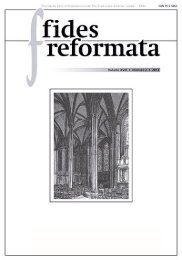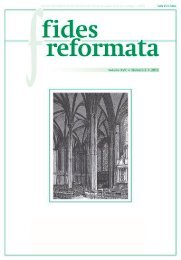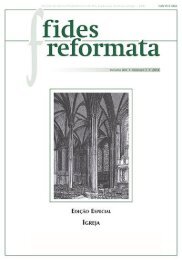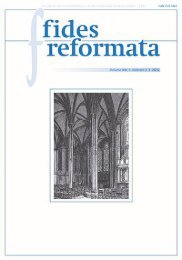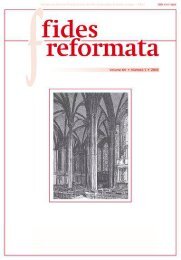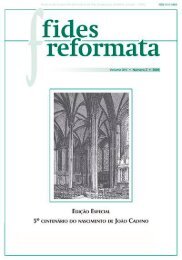Create successful ePaper yourself
Turn your PDF publications into a flip-book with our unique Google optimized e-Paper software.
FIDES REFORMATA XIX, Nº 2 (2014): 95-115<br />
I also take issue with the view with which John Robinson is often associated,<br />
that dates the Gospel of John even prior to 70 AD, 4 since the early Christian<br />
tradition lists this gospel as being published last. The word ‘published’ leaves<br />
room for the idea that the writer could have worked on the book earlier. In this<br />
regard I leave it undecided as to whether or not John made use of the Synoptic<br />
Gospels or had been acquainted with the synoptic tradition.<br />
I wish to attempt to answer the following question: in the Fourth Gospel<br />
who is the author referred to as “we”? Firstly, this question concerns the<br />
prologue and the epilogue when the first person plural is used, respectively:<br />
“we beheld his glory” (1:14) and “we know that his testimony is true” (21:24).<br />
Secondly, and as a supplement, other references by the author should also be<br />
considered, especially when the writer speaks directly to the readers. He uses<br />
remarkable congruity in regard to the witness about the death of the Crucified<br />
One: ‘He who saw it has borne witness – his testimony is true, and he knows<br />
that he is telling the truth – that you also may believe’ (<strong>19</strong>:35); as well as in<br />
regard to the aim of the gospel: “…these signs are written so that you may<br />
believe” (20:30-31). Prior to my exegesis I will provide my own translation<br />
of these four key texts and also of three other texts from the Johannine literature.<br />
5 The other texts (1 John 5:15; 3 John 9 and 12) are more or less parallel<br />
to the key texts.<br />
In the convention of the ancient Middle East, wis<strong>do</strong>m literature and<br />
prophetic writings bore the names of the authors but historiography was<br />
anonymously published. 6 Historians preferred to conceal their identity in their<br />
writings. That is also the case with the Fourth Gospel. The first generation<br />
readers knew by whom they were addressed. Readers from following<br />
generations could identify the author by the heading of the gospel text, through<br />
indications from the Church Fathers, or by reconstructing the identity of the<br />
beloved disciple and writer from the content. 7<br />
Along with the anonymity of historiography comes an expression of<br />
purpose written in the passive form. John says: ‘these [signs] are recorded’ ..,<br />
4 ROBINSON, John A.T. The priority of John. Lon<strong>do</strong>n: SCM Press, <strong>19</strong>85; BERGER, Klaus. Im<br />
Anfang war Johannes. Datierung und Theologie des vierten Evangeliums. Stuttgart: Quell, <strong>19</strong>97.<br />
5 All other Bible citations between <strong>do</strong>uble quotation marks are, unless otherwise indicated, taken<br />
from the English Standard Version.<br />
6 Different than in Greek-Roman historiography, where the author habitually mentions his name<br />
in the prologue. See BAUM, Armin D. The Anonymity of the New Testament History Books: A Stylistic<br />
Device in the Context of Greco-Roman and Ancient Near Eastern Literature. Novum Testamentum 50<br />
(2008), p. 120-142.<br />
7 The anonymity of the beloved disciple concurs with the anonymity of the gospel of which he is<br />
the author. According to Baum the usage of the third person in John can best be taken as autobiographical.<br />
See BAUM, Armin D. Autobiografische Wir- und Er-Stellen in den neutestamentlichen Geschichtsbüchern<br />
im Kontext der antiken Literaturgeschichte. Biblica 88 (2007), p. 473-495 [494-494].<br />
97






